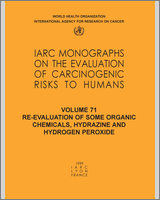NCBI Bookshelf. A service of the National Library of Medicine, National Institutes of Health.
IARC Working Group on the Evaluation of Carcinogenic Risks to Humans. Re-evaluation of Some Organic Chemicals, Hydrazine and Hydrogen Peroxide. Lyon (FR): International Agency for Research on Cancer; 1999. (IARC Monographs on the Evaluation of Carcinogenic Risks to Humans, No. 71.)
Data were last evaluated in IARC (1990).
1. Exposure Data
1.1. Chemical and physical data
1.1.1. Nomenclature
- Chem. Abstr. Serv. Reg. No.: 1163-19-5
- Chem. Abstr. Name: Benzene, 1,1′-oxybis[2,3,4,5,6-pentabromo]
1.1.2. Structural and molecular formulae and relative molecular mass

1.1.3. Physical properties (for details, see IARC, 1990)
- Boiling point: Decomposes at 425°C
- Melting point: 290–305°C
- Conversion factor: mg/m3 = 39.2 × ppm
1.2. Production, use and human exposure
Decabromodiphenyl oxide has been produced since the late 1970s as a flame retardant for use in plastics, especially high-impact polystyrene, and to treat textiles, such as automotive fabrics and tents. Occupational exposure to decabromodiphenyl oxide may occur during its production and use. It has also been detected in environmental samples collected near some production facilities (IARC, 1990).
2. Studies of Cancer in Humans
No data were available to the Working Group.
3. Studies of Cancer in Experimental Animals
Decabromodiphenyl oxide was tested for carcinogenicity by oral administration in one strain of mice and in two strains of rats. In one study in rats, it induced hepatocellular adenomas in animals of each sex and acinar-cell adenomas of the pancreas and mononuclear-cell leukaemia in males (IARC, 1990).
4. Other Data Relevant to an Evaluation of Carcinogenicity and its Mechanisms
4.1. Absorption, distribution, metabolism and excretion
4.1.1. Humans
No data were available to the Working Group.
4.1.2. Experimental systems
When labelled decabromodiphenyl oxide was given by gavage to rats, over 99% of the label appeared in the faeces, approximately 0.5% of mainly unchanged compound was found in the liver, less than 1% of the label was detected in the urine over 16 days and trace amounts of label were found in the kidneys, spleen, lungs, brain, muscle, fat and skin. After an intravenous dose, the faeces and gut contents contained 75% of the dose, suggesting significant biliary excretion, and of the extracted faecal label, 63% was metabolites. No evidence of induction of cytochrome c reductase or cytochrome P450 activities was seen in male rats. In a two-year dietary study in rats, the bromine content of liver and adipose tissue was slightly increased (IARC, 1990).
4.2. Toxic effects
No data were available to the Working Group.
4.3. Reproductive and developmental effects
No data were available to the Working Group.
4.4. Genetic and related effects
4.4.1. Humans
No data were available to the Working Group.
4.4.2. Experimental systems (see Table 1 for references)
Table 1
Genetic and related effects of decabromodiphenyl oxide.
In single studies, decabromodiphenyl oxide did not induce gene mutations in either bacteria or mouse lymphoma L5178Y cells and neither did it induce sister chromatid exchanges or chromosomal aberrations in Chinese hamster ovary CHO cells.
5. Evaluation
No epidemiological data relevant to the carcinogenicity of decabromodiphenyl oxide were available.
There is limited evidence in experimental animals for the carcinogenicity of decabromodiphenyl oxide.
Overall evaluation
Decabromodiphenyl oxide is not classifiable as to its carcinogenicity to humans (Group 3).
6. References
- IARC (1990) IARC Monographs on the Evaluation of Carcinogenic Risks to Humans, Vol. 48, Some Flame Retardants and Textile Chemicals, and Exposures in the Textile Manufacturing Industry, Lyon, pp. 73–84 [PMC free article: PMC7682352] [PubMed: 2374288]
- United States National Toxicology Program (1986) Toxicological and Carcinogenesis Studies of Decabromodiphenyl Oxide (CAS No. 1163-19-5) in F344/N Rats and B6C3F1 Mice (Feeding Studies) (Tech. Rep. Ser. No. 309), Research Triangle Park, NC, United States Department of Health and Human Services [PubMed: 12748720]
- Decabromodiphenyl oxide - Re-evaluation of Some Organic Chemicals, Hydrazine and...Decabromodiphenyl oxide - Re-evaluation of Some Organic Chemicals, Hydrazine and Hydrogen Peroxide
- Dichloromethane - Re-evaluation of Some Organic Chemicals, Hydrazine and Hydroge...Dichloromethane - Re-evaluation of Some Organic Chemicals, Hydrazine and Hydrogen Peroxide
- Chlorodibromomethane - Re-evaluation of Some Organic Chemicals, Hydrazine and Hy...Chlorodibromomethane - Re-evaluation of Some Organic Chemicals, Hydrazine and Hydrogen Peroxide
- Diglydicyl resorcinol ether - Re-evaluation of Some Organic Chemicals, Hydrazine...Diglydicyl resorcinol ether - Re-evaluation of Some Organic Chemicals, Hydrazine and Hydrogen Peroxide
- Dimethylcarbamoyl chloride - Re-evaluation of Some Organic Chemicals, Hydrazine ...Dimethylcarbamoyl chloride - Re-evaluation of Some Organic Chemicals, Hydrazine and Hydrogen Peroxide
Your browsing activity is empty.
Activity recording is turned off.
See more...
